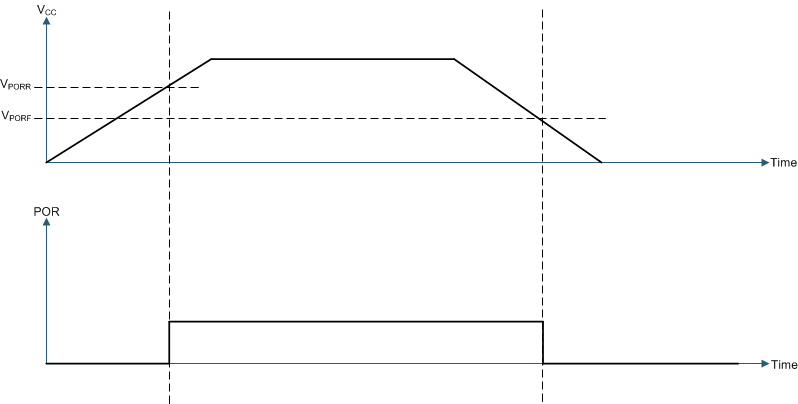ZHCSCR9C September 2014 – February 2017 TCA9534A
PRODUCTION DATA.
- 1 特性
- 2 应用
- 3 说明
- 4 修订历史记录
- 5 Pin Configuration and Functions
- 6 Specifications
- 7 Parameter Measurement Information
- 8 Detailed Description
- 9 Application and Implementation
- 10Power Supply Recommendations
- 11Layout
- 12器件和文档支持
- 13机械、封装和可订购信息
封装选项
机械数据 (封装 | 引脚)
散热焊盘机械数据 (封装 | 引脚)
- DW|16
订购信息
10.1 Power-On Reset Requirements
In the event of a glitch or data corruption, the TCA9534A can be reset to its default conditions by using the power-on reset feature. Power-on reset requires that the device go through a power cycle to be completely reset. This reset also happens when the device is powered on for the first time in an application.
The two types of power-on reset are shown in and Figure 38.
 Figure 38. VCC is Lowered Below the POR Threshold, then Ramped Back Up to VCC
Figure 38. VCC is Lowered Below the POR Threshold, then Ramped Back Up to VCCTable 8 specifies the performance of the power-on reset feature for the TCA9534A for both types of power-on reset.
Table 8. Recommended Supply Sequencing and Ramp Rates(1)
| PARAMETER | MIN | MAX | UNIT | ||
|---|---|---|---|---|---|
| VCC_FT | Fall rate | See Figure 38 | 1 | 2000 | ms |
| VCC_RT | Rise rate | See Figure 38 | 0.1 | 2000 | ms |
| VCC_TRR | Time to re-ramp (when VCC drops to VPOR_MIN – 50 mV or when VCC drops to GND) | See Figure 38 | 1 | μs | |
| VCC_GH | Level that VCCP can glitch down to, but not cause a functional disruption when VCCX_GW = 1 μs | See Figure 39 | 1.2 | V | |
| VCC_MV | The minimum voltage that VCC can glitch down to without causing a reset (VCC_GH must not be violated) | See Figure 39 | 1.5 | V | |
| VCC_GW | Glitch width that does not cause a functional disruption when VCCX_GH = 0.5 × VCCx | See Figure 39 | 10 | μs | |
Glitches in the power supply can also affect the power-on reset performance of this device. The glitch width (VCC_GW) and height (VCC_GH) are dependent on each other. The bypass capacitance, source impedance, and device impedance are factors that affect power-on reset performance. Figure 39 and Table 8 provide more information on how to measure these specifications.
VPOR is critical to the power-on reset. VPOR is the voltage level at which the reset condition is released and all the registers and the I2C/SMBus state machine are initialized to their default states. The value of VPOR differs based on the VCC being lowered to or from 0. Figure 40 and Table 8 provide more details on this specification.
 Figure 40. VPOR
Figure 40. VPOR